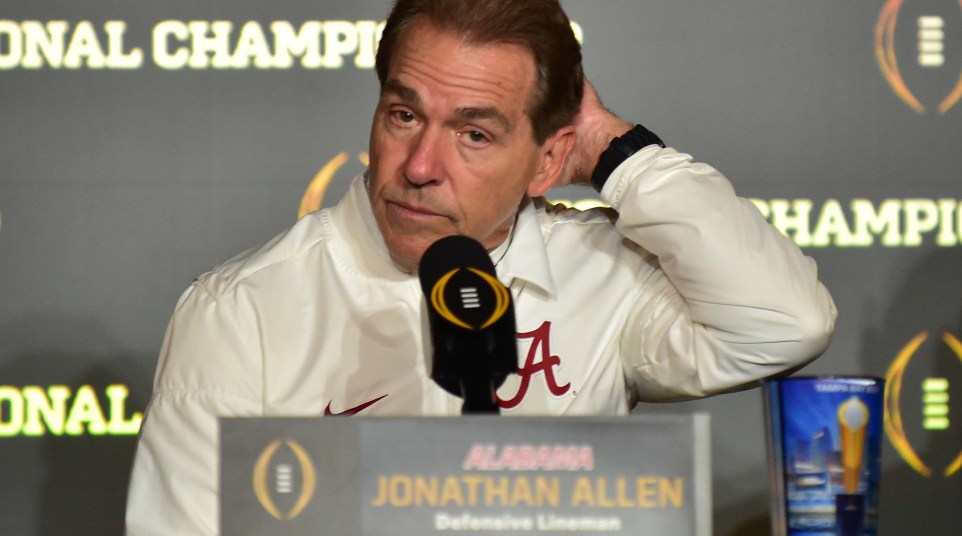
5 things Alabama needed to do better against Clemson
After dominating throughout the 2016 season, Alabama fell short in the final second of the one game that mattered most.
The season, as a whole, won’t provide much comfort for a team that appeared destined to win its fifth national championship under Nick Saban and solidify itself as the premier dynasty in college football history.
Credit Clemson for its ability to make plays down the stretch, but Alabama missed some opportunities to put the game away in the second half, and the injury to Bo Scarbrough didn’t help. Alabama, which relied on non-offensive points all season, forced two turnovers, but scored just three points off them. And nobody could have anticipated Clemson scoring 21 points in the fourth quarter against the nation’s best defense.
Let’s rewind the tape and figure out what went wrong for the Tide.
1. Stick to the run game in the second half: Alabama’s offense is at its best when it can run the ball. Three of the Crimson Tide’s four touchdowns came on touchdown runs of 25 yards or longer, which is an indication that there were holes to be exploited.
Look familiar??? Bo Scarbrough goes 37 yards for his second TD of the game!!! ???. Scarbrough: 8 carries, 71 yds, 2 TD. Heard on @ESPNRadio. pic.twitter.com/25DruRlSyj
— ESPN Radio (@ESPNRadio) January 10, 2017
In the second half, a time when Alabama should have favored the run, the Tide ran the ball 13 times and aired it out 16 times. Alabama averaged 6 yards per carry in the second half, but relied too much on Jalen Hurts’ arm down the stretch.
Losing Scarbrough impacted the Tide’s confidence in the run game against Clemson’s physical front, but he wasn’t even the team’s starter for much of the season. Alabama went away from its strength at a time when it should have doubled down.
2. Secure the tackle: Throughout the season, Alabama’s defense was among the best at wrapping up ball carriers and getting them to the ground. Against Clemson, the Crimson Tide missed 17 tackles.
These missed opportunities allowed the Tigers to continue drives and generate explosive plays. On the season, Alabama missed about 90 tackles. It missed 19 percent of that total in its biggest game of the season.
It’s hard to fault the Tide’s defense after the year that group had, but they slipped in their fundamentals a bit and it came back to haunt them.
3. Open up the playbook: With a true freshman quarterback at the helm and a new offensive coordinator calling the shots, Alabama looked conservative on offense for much of the game.
Many of the Crimson Tide’s pass plays were quick throws or screens. Only six of Hurts’ 31 pass attempts were thrown over 10 yards in the air. This inability to stretch the field vertically allowed Clemson to play inside the box and close some of Hurts’ throwing lanes.
O.J. Howard’s 68-yard touchdown was the result of Clemson expecting the short pass and becoming too aggressive. It was the payoff of all the quick throws Alabama made, but the Tide didn’t do enough down the stretch to reap the benefits of that early game plan.
Film Room during OJ Howard TD.
They're all over it.
While protecting the identity of the safety. pic.twitter.com/tvnrttlHuL— Matt Schick (@ESPN_Schick) January 10, 2017
On Alabama’s final possession, Steve Sarkisian opened up the playbook just a bit and the Crimson Tide put together its first six-play drive since the middle of the first quarter. Let Hurts be Hurts; the national championship game isn’t the time to be ultra-conservative, even with a freshman quarterback.
4. Convert on third down: Alabama was abysmal on third down against Clemson, there really isn’t another way to put it. The Crimson Tide converted just two of their 15 third-down attempts.
Both conversions came via a run play, but Alabama averaged just 2.2 yards per carry on third down. Hurts didn’t fare any better through the air, completing just 4-of-9 passes for 32 yards. The Crimson Tide didn’t help themselves much on early downs, either. Alabama’s average third-down distance was 9.3 yards.
5. Continue to bring the pressure: There wasn’t much that the Crimson Tide’s secondary could do to slow down Clemson’s plethora of weapons in the receiving game. Alabama had success in the second half bringing pressure against Deshaun Watson, though.
It’s hard to believe that Alabama went away from blitzing Watson when it was so effective, but perhaps the Tide couldn’t adjust when Clemson began to counter those blitzes. Or maybe the Tide were too tired to get to him on the final two drives. Clemson ran 99 offensive plays, the most any Alabama defense has faced.
Still, there were too many times when Watson had time late in the game to make a big throw downfield.
Alabama’s pass rush is second to none, but it didn’t play a role down the stretch.
William McFadden covers the University of Georgia and the University of Alabama for Saturday Down South. For insight on these two SEC powerhouses, follow him on Twitter @willmcfadden.
